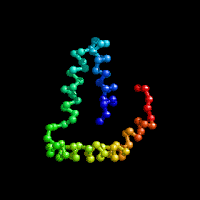Homology modelling is most common method used for protein tertiary structure prediction. Homology modelling is based on the principle that protein with similar amino acid sequence will also share the similar structure.
Protein 3D Structure Prediction Tutorial
I. Basic of protein structure and function
II. Methods of protein modelling
III. ab initio/ denovo potein modelling
1. Template recognition : finding a suitable, homologous protein of which the structure has been solved
2. Target-template alignment and editing : generating the initial alignment between that template (identified homologous protein) and the model sequence. Further alignment can refined using knowledge obtained from the template structure
3. Backbone generation: backbone of future model will be generated based on the alignemnt
4. Loop modeling : since the alignment between model and template sequence may contains gaps therefore gaps in the model must be closed, and because of this loops are ab initio constructed.
5. Side chain modeling: the side chains will be added to the newly created model using rotamer libraries to find the best rotamer for that local backbone conformation
6. Model optimization : unfavorable bond lengths, bond angles, torsion angles and contacts will be removed by minimizing the energy that can help to regularize local bond and angle geometry and to relax close contacts and geometric chain.
7. Model quality evaluation and subsequent optimization : newly created model will be checked for any remaining errors and further optimized.
 |
| Steps in protein homology modeling |
Before going to model your protein using any homologous structure, you shouls always be cautious about some factors which determined the final quality of generated models. Error in protein model can be come from :
1. Incorrect template : Homology models are classified into 3 area in terms of their accuracy and reliability.
- Midnight Zone: < 20% sequence identity. The structure cannot reliably be used as a template.
- Twilight Zone: 20% - 40% sequence identity. Sequence identity may be used for structural identity.
- Safe Zone >40% sequence identity. can be used reliably.
Beside the identity at amino acid level, quality of crystal structure of template protein is also important. So if more than one template is available for your protein then it is always good to consider other factors like X-ray resolution, the (free) R-factor and the real-space R-factor before choosing the final template.
 |
| Limiting steps of homology modelling |
2. Misalignments : always give a close look to your sequence-template alignment because this is the base of quality of your final model.
2. Protein homology modelling tutorial HERE
3. Protein structure homology modeling using SWISS-MODEL workspace HERE
4. Homology Modeling for Beginners HERE
Part-V : Software and servers for protein homology modeling



Post a Comment